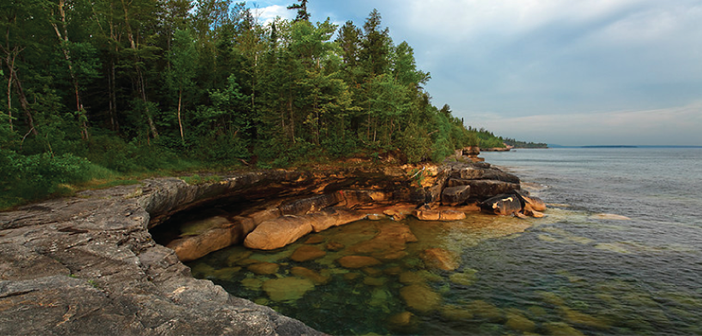Hexagon Geospatial is invested in the future of the geospatial industry, and our education customers play a big role in our investment. That is why we continue to boost education initiatives offering students and professors partnership opportunities, programs, and grants for academic projects to expand learning. As one of these initiatives, we were excited to bring back the Hexagon Geospatial EDU Contest for HxGN LIVE 2018. We started this contest with the goal of engaging some of the brightest geospatial minds to discover how they are using our software to shape smart change in the world.
Although there could only be one winner, we had a special contest honorable mention that we would like to spotlight – Parth Bhatt, Master’s Student and Research Assistant at Michigan Technological University.
Read Parth’s submission to learn more about how he is using Hexagon Geospatial technology in his research. You can also watch Parth’s presentation on our website.
Parth’s Abstract:
Wetlands are a major ecologically important natural resource. The North American Great Lakes have the longest fresh-water shoreline in the world, and many miles of unique coastal wetlands. Delineation and classification of coastal wetlands vegetation is a critical component to their preservation and management. Of particular interest to this study is Phragmites, a common reed growing in coastal fens, sedge meadows, and emergent marshes. One subspecies (P. americanus) is native and intermixes with other native plants to provide habitat for a wide array of wildlife. A second subspecies (P. australis) is invasive and forms dense monocultures. These dense monocultures outcompete native plants and reduce vegetation diversity. To protect and manage native wetlands, accurate delineation and mapping of Phragmites locations, and distinguishing P. australis from P. americanus is needed. Historically, Phragmites mapping efforts used GPS combined with aerial and/or satellite imagery. However, these methods proved to be expensive, time consuming, and limiting in terms of spatial resolution and extent/frequency of coverage. Our study is exploring the potential use of Unmanned Aerial System (UAS) to acquire near-infrared imagery with centimeter scale spatial resolution to map coastal wetland vegetation in general and the Phragmites community specifically. The imagery (~ 40,000 images) was collected the summer of 2017 over three areas of the Hiawatha National Forest along the Lake Michigan shoreline in Michigan’s Upper Peninsula.
Preprocessing, including tie point generation and orthorectification, is challenging due to the physical size of the images, large amounts of hard disk space required and access to adequate RAM. Each image in a single block is approximately 10 MB, having 7,360×4,912 dimension, which requires a minimum of 16 GB RAM (32 GB is recommended) and 150-300 GB of hard disk space on a computer working with an I7 or Xeon processor. Thirty imagery blocks for the study areas were processed, with each block composed of 800 to 1,000 images.
Agisoft PhotoScan Pro, which uses Structure-from-Motion algorithms (Agisoft 2018) generates point clouds, connecting mesh, and an orthomosaic. X, Y and Z coordinates from the UAS are imported into Photoscan Pro as a .csv file to define camera position. Camera calibration values are entered manually. Point cloud generation includes photo alignment and tie point generation, camera optimization, and dense point cloud creation. The software corrects image distortion, followed by a multi-view stereo reconstruction procedure resulting in each pixel located in its correct X, Y and Z position.
Mosaicking of the orthophotos utilizes ERDAS IMAGINE’s MosaicPro tool. The program efficiently processes the large datasets, which range from 50 to 200 GB. During processing, the Active Area Option, Edge Function, is used to add the images to ensure imagery extents are recognized. Automatic seamlines are generated using the Weighted Seamline function, and Feathering is chosen to soften the edges. Nearest neighbor interpolation is selected for the resampling option to maintain vegetation detail which is critical for discriminating different vegetation types and individual species. For the final output, a single mosaic is generated containing all the blocks within a manually created area of interest (AOI).
Preliminary analysis quickly reveals traditional classification approaches are not adequate to delineate and identify the needed land cover classes. Consequently, the intensity, hue and saturation (IHS) transformation paired with texture is being evaluated. Results from the IHS transformation provide bands which highlight various vegetation types, such as phragmites, conifers, hardwoods, ridge and swale vegetation and shadows to name a few. With the very fine spatial resolution, most of the information in the imagery is found in the spatial structure of the vegetation, rather than in the spectral characteristics typical of satellite and medium scale aerial imagery. Closely allied to the spatial structure, texture is proving to be one of the key characteristics for classification and interpretation with the UAS imagery. Using the IHS layers and moving window sizes of 11×11 and 101×101 texture, variance is calculated. The resulting texture variance from the hue layer is discarded due to lack of meaningful information. These moving window sizes are not arbitrary. Rather they correlate to the structural size, such as crown diameter and plant supporting structures, of various the vegetation types to be differentiated. The 11 X 11 window is approximately 15 cm in size, and the 101 X 101 window is equivalent to approximately 1.3 m. Processing the imagery, due to its large size, is computationally intensive. Creating the 101-pixel window texture layer requires 15-20 days of processing time using a 16GB RAM computer.
Supervised classification results using a maximum likelihood classification approach have large errors of misclassification (commission) for the vegetation information classes. Confusion between various vegetation classes, water classes, sand-gravel beach and phragmites occurs. Applying a 7×7 majority smoothing filter twice to reduce the “salt and pepper” did not significant improve classification accuracy.
A second approach using the Knowledge Engineer program has promising results. A knowledge tree populated with decision rules to utilize SSURGO soils data, National Wetlands Inventory (NWI), DEM, hydro-geomorphic data along with the texture variance results for the IHS transformation were developed. Preliminary output from this classification approach shows good results. Northern Fen, Boreal Hardwood/Conifer, open water, sand-gravel beach and most importantly phragmites were differentiated. Research is continuing using this approach for the 3 study areas.
Again, we would like to congratulate Parth on his hard work and for his innovation in the use of Hexagon Geospatial technology.
















